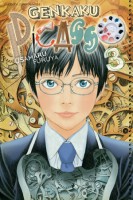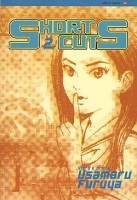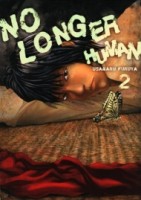 Creator: Usamaru Furuya
Creator: Usamaru Furuya
Original story: Osamu Dazai
U.S. publisher: Vertical
ISBN: 9781935654377
Released: February 2012
Original release: 2011
Osamu Dazai’s semi-autobiographical novel No Longer Human, originally published in Japan in 1948, has had a least three manga adaptations. Of those, only one is currently available in English–a three-volume series by Usamaru Furuya. I have been interested in Furuya’s work ever since I read Lychee Light Club, and so I was very happy when Vertical licensed his No Longer Human manga series. No Longer Human, Volume 3 was first published in Japan in 2011 while the English-language edition was released in 2012. The original novel was a fairly dark work. While Furuya has taken some liberties with his version of the story–using himself as a framing character and updating the setting to contemporary Japan, among other changes–the No Longer Human manga is also quite dark. Furuya argues in the afterword that his ending is somewhat more uplifting than Dazai’s, but it is still severe. Vertical describes the third volume as “the devastating finale” which is incredibly apt.
Disowned by his family and the survivor of a double suicide, Yozo Oba’s life was falling apart. Getting by on his good looks, he lived for a time as a kept man until he ran away from that situation, too. But then he met and fell in love with Yoshino, a young woman working at the cigarette shop that he frequented. Yoshino and Yozo elope and have now been married for a year. For the first time in his life Yozo is genuinely happy. He has a wonderful trusting wife who loves and accepts him for who he is, the only person with whom he can be completely open and honest. He’s gainfully employed, his manga for children is popular and selling well and with the extra income from his side job drawing erotic illustrations, he and Yoshino are able to live quite comfortably. Yozo still carries some guilt over his past, something that his supposed friend Horiki never lets him forget, but he’s now starting to look forward to his future. And then it all comes crashing down. Yozo’s perfect fantasy life is destroyed and he is destroyed along with it.
Having previously read Dazai’s orignal novel (several times, actually), I was all too aware the direction that Furuya’s No Longer Human was heading. Actually, from the beginning of the manga series alone it is known that Yozo’s story is not a happy one. But knowing what’s in store does not necessarily make it any easier to witness it happen. There is nothing that the reader can do but to watch the events unfold. Yozo is doomed from the very start. Something happens to this young man, seemingly loved by all, to cause his life to completely shatter. He should be in the prime of his youth but becomes so broken that most assume him to be more than twice his age. The third volume of Furuya’s No Longer Human outlines his final and ultimate downfall, the one from which he is never to recover. It’s made even more tragic because he has finally experienced true happiness and contentment only to have it torn from his grasp.
Throughout the No Longer Human manga the tremendous disconnect between how Yozo views himself and how others perceive him has been shown. It’s one of the driving forces behind the story. Up until the very end people insist that Yozo is a good person, but to him it has all been an act. He holds a pessimistic view of the world and recoils from humanity. What many people would consider to be a source of hope and salvation only guarantees Yozo’s undoing. Eventually he becomes a drug addict which only amplifies his fears and anxieties and further damages his precarious state of mind. His increasingly twisted and tormented psyche is reflected quite clearly in Furuya’s artwork. No Longer Human is an unrelenting and even terrifying tale. Even at his worst I can still see a little bit of myself in Yozo. It’s perhaps because of this that I find the series to be so effectively gut-wrenching. Furuya’s adaptation of Dazai’s novel is excellent, bringing his own interpretation to the story while staying true to the dark heart of the original.





